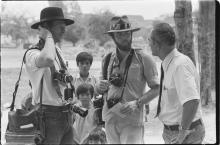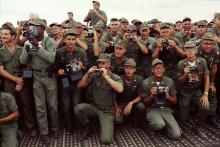
The permanent exhibition galleries at the Gerald R. Ford Presidential Museum in Grand Rapids, Michigan, allow visitors to explore key moments in President Gerald R. Ford and First Lady Betty Ford's lives and careers. Visitors learn about the impact of democratic citizenship through visually captivating displays and models, archival photography, sculptures, clothing, and other exhibits. Visitors can also visit a temporary exhibit gallery, which features a changing array of temporary and traveling exhibits on a wide range of subjects.
The Gerald R. Ford Presidential Library in Ann Arbor, Michigan, features a permanent timeline exhibit on the lives of Gerald and Betty Ford, along with several small temporary exhibits each year.

Casting Light: Photographs of the Vietnam War
Library - Ann Arbor
On-Site
-
2025 marks the 50th anniversary of the end of U.S. involvement in Vietnam. This exhibit uses photographs to provide a moving, intimate, and powerful look at the Vietnam War, capturing how presidents grappled with the reality of war and the American public’s changing responses to the conflict. Visitors can explore the history of the war and view iconic prints from American photojournalists.

Modern Quilt Guild Exhibit
Library - Ann Arbor
On-Site
-
We are thrilled to welcome back the Ann Arbor Modern Quilt Guild to the Gerald R. Ford Presidential Library! The Modern Quilt Guild Exhibit features an array of hand crafted and one-of-a-kind pieces that celebrate the unique art form that is quilting. Many of the designs focus on the use of negative space, improvisational techniques and the use of modern fabrics. The temporary exhibit will be on display in our auditorium during December and January and is free to visitors.

Casting Light: Photographs of the Vietnam War
Museum - Grand Rapids
On-Site
-
2025 marks the 50th anniversary of the end of U.S. involvement in Vietnam. This showcase exhibit uses photographs to provide a moving, intimate, and powerful look at the Vietnam War, capturing how presidents grappled with the reality of war and the American public’s changing responses to the conflict. Visitors can explore this panel exhibit to learn more about the conflict and reflect on its lingering impacts.

175 Pictures for 175 Years
Museum - Grand Rapids
On-Site
-
In celebration of the 175th anniversary of the incorporation of Grand Rapids, the Gerald R. Ford Presidential Museum is hosting a mobile museum exhibit featuring 175 photos that highlight key moments of the city’s history.
The exhibit is presented by the Grand Rapids Public Museum, and representatives from the Grand Rapids City Archives, the Grand Rapids Public Library, the Grand Rapids African American Museum and Archives, the Grand Rapids Historical Commission, and the Grand Rapids Historical Society worked together to develop this exhibit with images from their vast public collections.
The exhibit, in the Museum's lobby, will be free to visitors.